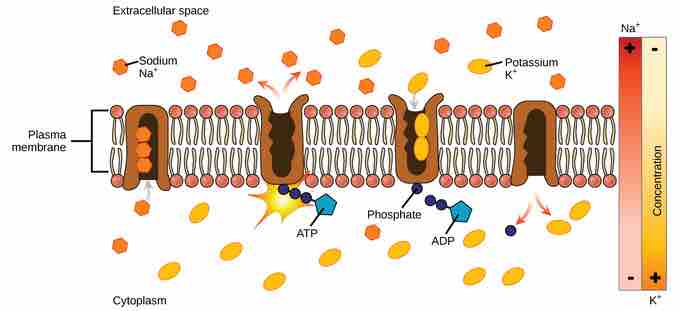Primary Active Transport
The primary active transport that functions with the active transport of sodium and potassium allows secondary active transport to occur . The secondary transport method is still considered active because it depends on the use of energy as does primary transport.

Active Transport of Sodium and Potassium
Primary active transport moves ions across a membrane, creating an electrochemical gradient (electrogenic transport).
One of the most important pumps in animals cells is the sodium-potassium pump (Na+-K+ ATPase), which maintains the electrochemical gradient (and the correct concentrations of Na+ and K+) in living cells. The sodium-potassium pump moves two K+ into the cell while moving three Na+ out of the cell. The Na+-K+ ATPase exists in two forms, depending on its orientation to the interior or exterior of the cell and its affinity for either sodium or potassium ions. The process consists of the following six steps:
- With the enzyme oriented towards the interior of the cell, the carrier has a high affinity for sodium ions. Three sodium ions bind to the protein.
- ATP is hydrolyzed by the protein carrier, and a low-energy phosphate group attaches to it.
- As a result, the carrier changes shape and re-orients itself towards the exterior of the membrane. The protein's affinity for sodium decreases, and the three sodium ions leave the carrier.
- The shape change increases the carrier's affinity for potassium ions, and two such ions attach to the protein. Subsequently, the low-energy phosphate group detaches from the carrier.
- With the phosphate group removed and potassium ions attached, the carrier protein repositions itself towards the interior of the cell.
- The carrier protein, in its new configuration, has a decreased affinity for potassium, and the two ions are released into the cytoplasm. The protein now has a higher affinity for sodium ions, and the process starts again.
Several things have happened as a result of this process. At this point, there are more sodium ions outside of the cell than inside and more potassium ions inside than out. For every three ions of sodium that move out, two ions of potassium move in. This results in the interior being slightly more negative relative to the exterior. This difference in charge is important in creating the conditions necessary for the secondary process. The sodium-potassium pump is, therefore, an electrogenic pump (a pump that creates a charge imbalance), creating an electrical imbalance across the membrane and contributing to the membrane potential.